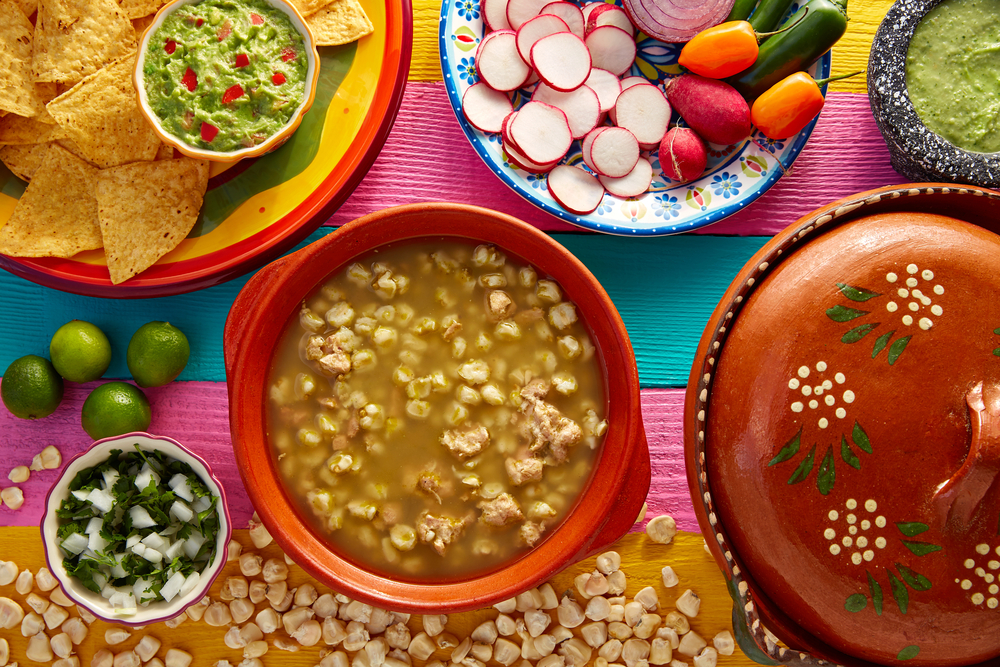Each year Mexican Independence Day begins at midnight on September 15th with fireworks, the famous “grito” or shout of the revolution, and then a day that follows of family and food. In kitchens and restaurants across Mexico pozole is served, a hearty soup made from hominy and pork, dressed up with chiles, salsas, sliced radishes and lime. The dish has long been part of Mexico’s cultural heritage and has as many regional peculiarities as Mexican society itself. Where did it come from? Let’s take a look back.
Related: A Cheater’s Guide to Pozole
The beginning of pozole is not without its dark days. No one will be sacrificed for this year’s Independence Day pozole, but if you had tried it 500 years ago, you just might have bitten down into the calf of a slave. Fray Bernardino de Sahagún, one of the New World’s most famous Spanish ethnographers and anthropologists, recounted a meeting with Aztec king Moctezuma during the festival of the god Tonatiuh where his royal highness was served a steaming bowl of pozole with a the leg of an imprisoned and sacrificed slave. It was all for the gods. [pagebreak]
Tonatiuh was the Aztec sun god, believed to be the fifth sun, in whose era the Aztecs were currently living. According to Aztec mythology, Tonatiuh required human sacrifice in order to continue his daily journey across the sky. Thousands of people would be killed each year in his honor during the Aztec reign of the Valley of Mexico. This may be why not that long ago pozole was considered a funeral dish instead of being eaten on Mexico’s biggest holiday of the year. These days, pozole takes on a new form, with a foundation in corn.
Related: 6 Best Bowls of Pozole in San Diego
The dish’s name is derived from the Nahuatl word pozolli which means foam. Cacahuazintle corn (a combination of the nahuatl words for cacao and corn), a large white dent heritage corn native to Mexico, creates that foam as it bursts into tiny florets while being boiled for the soup. This kind of corn is used to make sweets and tamales in certain parts of the country but its main use is for pozole. [pagebreak]
To make pozole, the corn is first soaked in lye, undergoing a process called “nixtamalization” which softens the kernels and allows the tough outer shell to be removed easily. While this is taking place, pork meat, which can include bones, ribs, or the animal’s head are boiled in water along with onion and garlic. Once the meat is finished cooking, it’s removed from the broth and pulled from the bones to be placed in the bottom of deep pozoleros, pozole bowls.
The nixtamal corn (now looking like what in English would be called hominy) is placed in the pork broth to continue cooking until it bursts open. That corn soup is ladled atop the pork and then garnished with an endless variety of condiments: lime, chile powder, oregano, chopped onion, sliced radishes, salsas, or lettuce.
There are three main types of pozole – a white, red, and green version – put together they resemble the Mexican flag and are a perfect dish for independence day! Green and red pozole follow the same process described above, but in addition to the ingredients listed include red or green chiles (usually ground or in the form of a salsa or paste) and various herbs that give them each a distinctive taste. [pagebreak]
All over the country the recipe has its unique variations. Along the coast you’ll find pozole with sardines in it, and in Acupulco with chopped up hard-boiled egg. In Jalisco you can find shrimp pozole made with the same kind of corn, shrimp broth, ground dried shrimp, chile de arbol, onion, and white vinegar. In Pátzcuaro, Michoacán pozole sometimes includes kernels of red corn and in Oaxaca it often has hoja santa or Mexican pepper leaf.
Most Mexicans will tell you that Mexico’s best pozole comes from their mother’s kitchen but in Mexico City there are several favorite spots for enjoying this delicious holiday soup. Casa Licha, in the southern Mexico City neighborhood of Sierro Justo is famous for their delicious pozole which you can order in all three variations – red, green and white.
The restaurant is run out of the former home of two school teachers who started a simple weekend pozole operation for friends and family and now have one of the premier pozole locations in the city. They still open only on Saturdays and Sundays and have a little shop next door where you can purchase arts and crafts from the state of Guerrero. [pagebreak]
La Casa de Don Toño is a large chain restaurant that’s a favorite among chilangos (Mexico City residents) for its pozole. They have almost 30 locations throughout the city and are open every day of the week. The restaurant was started in 1983 by Toño himself when he was only 18 years old, as a once-a-month Sunday restaurant, their fame soon spread and Toño found himself giving up his career in Law to cook and run restaurants full time.
El Pozole de Moctezuma in Mexico City’s central Guerrero neighborhood serves a typical recipe from the state of Guerrero, original home of the owner. They sell green and white pozole with accompaniments like fried pig skin (chicharron), hard-boiled egg, sardines and avocado. If you want to eat there on Independence Day you best make a reservation in advance or be disappointed.


![Making Mealtime Matter with La Familia: Easy Sofrito [Video]](https://thelatinkitchen.com/wp-content/uploads/2015/10/sofrito-shutterstock__0-500x383.jpg)
![Easy Latin Smoothies: Goji Berry Smoothie [Video]](https://thelatinkitchen.com/wp-content/uploads/2015/12/goji_berry-shutterstock_-500x383.jpg)
















![Fun and Fast Recipes: Fiesta Cabbage Salad [Video]](https://thelatinkitchen.com/wp-content/uploads/2015/11/fiesta_cabbage_slaw-shutterstock_-500x383.jpg)









